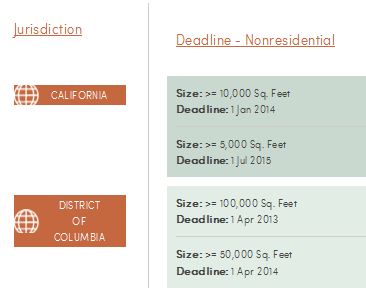Last week, IMT and the Global Buildings Performance Network re-launched Building Rating, a website that provides transparent and detailed energy and water benchmarking information on cities, counties, states, and countries throughout the world.
Those familiar with the previous version of the site will notice it has a more organized and elegant structure, while also offering enhanced functionality for users (watch this two-minute video for a quick demonstration). The ease with which users can now view and compare energy and water data among jurisdictions will hopefully help push the benchmarking policy landscape forward and motivate more jurisdictions into action, as policymakers can now easily assess the commendable benchmarking initiatives being undertaken worldwide.
By taking into consideration other successful benchmarking and disclosure programs, perhaps a city with voluntary benchmarking standards will consider making them requirements; or maybe a county with no history of benchmarking will look into rolling out a pilot program. Everyone can now see Seattle’s impressive compliance rates, or the number of countries in the European Union that have implemented national programs. After seeing what other regions are achieving, other jurisdictions who visit the site may be encouraged to match or even surpass these high standards.
 Using the Website
Using the Website
The policy comparison tool is the site’s crown jewel. In short, it’s the most effective tool to identify and illustrate similarities and differences among various benchmarking policies. For example, if you’re analyzing benchmarking policies in the United States, you can use the policy comparison tool to select the U.S. jurisdictions and relevant policy elements—say you want to compare the deadlines for non-residential, multifamily, and public buildings; simply select these three policy elements and the U.S. jurisdictions you wish to investigate, and click “Compare These Policies.” You can then export your report as a .CSV file, which in turn can be manipulated within a spreadsheet program like Microsoft Excel. Alternatively, you can display the report in “Print view”, which can become a slide in a PowerPoint presentation.
Another innovative feature of the site is the jurisdiction map. All of the colored jurisdictions on the map have engaged, to varying degrees, in activities related to building rating and performance. Perhaps you’re interested in the initiatives Australia has undertaken. If you hover the cursor over Australia, a brief description of the country’s benchmarking policies will appear on the screen. By clicking on Australia, you can go to the country’s detailed jurisdiction page.
While most jurisdictions have only one policy, Australia has two, each of which can be selected using the tabs at the top of the page. The relevant policy information will then appear below the highlighted tab. In the right column, you can find both “Jurisdiction Updates” (announcements, news articles, and blog posts) and “Related Documents” (documents and graphics) pertaining to Australia.
Building Rating has other features that should not be overlooked, including powerful search capabilities as well as “Get Updates” and “Additional Resources” pages. Together, these features give you a number of different ways to get the information you need about policies that promote energy and water use transparency in buildings, fitting for a website dedicated to “Sharing Transparency for a More Efficient Future.”
We’ve done our best to make Building Rating a visually appealing, content-rich site that facilitates the “benchmarking experience” for our users. We welcome your comments and questions, and please let us know if there’s any content you think we should update or add to the site.